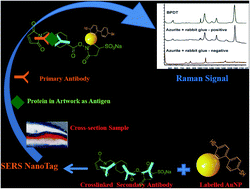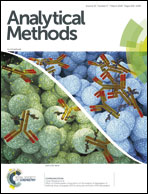A simplified protocol for the usage of new immuno-SERS probes for the detection of casein, collagens and ovalbumin in the cross-sections of artworks
Abstract
Although it is now relatively simple to identify protein binders in works of art, their proper localization within the corresponding layer still represents a significant analytical challenge. Until now, the identification of proteins has been allowed e.g. by peptide mass fingerprinting using mass spectrometric methods and their localization has been realized using optical microscopy by application of fluorescent stain Sypro Ruby (SR) on polished cross-sections. In this work we propose a novel and simplified protocol for immuno-surface enhanced Raman scattering (immuno-SERS) using gold nanoparticles attached to biphenyl-4,4′-dithiol (BPDT) as the SERS-nanotag. These in-laboratory easily obtainable labeled nanoparticles have been applied on multilayered mock-up samples prepared as cross-sections. The layers contain egg, casein, and different animal glue binders (prepared in various ratios with linseed oil or a carbohydrate component) mixed with azurite, vermilion and chalk. On the model samples the sensitivity of Sypro Ruby has been tested for comparison between the reported protocol and the current procedure for the first time. Protein detection possibilities of both the methods are shown in this paper.



 Please wait while we load your content...
Please wait while we load your content...